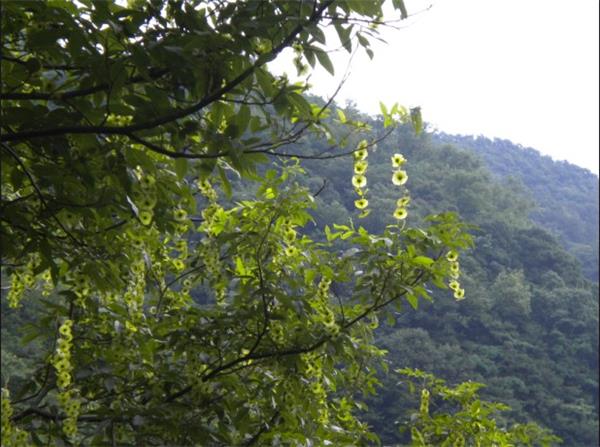Is it worth planting Cyclocarya paliurus?
Cyclocarya paliurus is a kind of tree species with both ornamental value and medicinal value, but to ensure that its quality is not destroyed, it is necessary to pay more attention to cultivation and conservation.

Cultivation Techniques of Cyclocarya paliurus
Habits: Cyclocarya paliurus original distribution area in the 800~1200m above sea level mountain humid forest, adult trees like light, seedlings slightly tolerant of shade; requirements of deep soil layer, acidic soil, like weathered rock wet soil; drought resistance, strong germination, growth medium speed.
Seed collection: Cyclocarya paliurus is monoecious, Lueyang local late September to early October, when the fruit from green to yellow brown, fruit naturally landing collection. Remove the wings of the picked seeds, clean the seeds, store them in bamboo baskets, dry them in the shade, and store them in bags in ventilated places indoors. 95% concentrated sulfuric acid is put into a pottery container, then the seeds of Cyclocarya paliurus are put in, soaked for 11 hours, taken out, repeatedly washed in flowing clear water for 2 hours, and then soaked in 50 DEG C warm water for 24 hours by adding gibberellin.
Sowing: Sowing should be carried out from November to December to reduce the risk of spring sowing in the sand storage link of Cyclocarya paliurus. Sowing method was adopted, the spacing of strips was 25~ 30cm, the depth of sowing ditch was 2cm, the thickness of covering soil was about 1.5cm, the sowing rate was 2~ 5kg/667m2, and after sowing, straw curtain was covered to keep warm and slow down the influence of soil hardening on germination rate of Cyclocarya paliurus. In early April of next year, the grass curtain shall be removed and 75% shade net shall be used to avoid the influence of direct sunlight on the seedlings of Cyclocarya paliurus.

Seedling: Cyclocarya paliurus seedlings should choose convenient irrigation, fertile loam nursery. 500kg decomposed manure and 200kg calcium magnesium phosphate fertilizer are applied per 667 square meters, and the furrow is built after ploughing. After the seedlings are unearthed, they need a lot of nutrients. In addition to applying sufficient base fertilizer, they should be topdressed in time. Nitrogen fertilizer should be applied twice in May to June, and intertillage and weeding should be carried out in time. Shed in summer and summer. Remove the shade and stop fertilizing after autumn.
Diseases and pests: the main disease is seedling blight, also known as damping-off disease, generally occurs in June to July, rainy season to do a good job of drainage and waterlogging prevention, to prevent seedling blight. Prevention must be more important than cure, prevention is the main, seedlings can be sprayed with 0.5%~1% equivalent Bordeaux mixture or 2% ferrous sulfate about 10 days after emergence, and then sprayed alternately every 7~10 days (pay attention to washing seedlings with clean water). Underground pests mainly include cutworm, grubs, etc., combined with watering, zinc phosphorus, lindane and other pesticides for control. In addition, attention should be paid to the sunburn, sunburn, seedling lodging direction consistent, and blight occurred, seedling lodging direction is not regular.

The role and efficacy of Cyclocarya paliurus
1. Cyclocarya paliurus preparation has hypoglycemic effect but no influence on normal blood sugar, has no toxic side effect, has synergistic effect with hypoglycemic drugs, has good effect on eliminating diabetic symptoms, preventing complications and toxic side effects of hypoglycemic drugs, is an optional auxiliary method for treating type II diabetes, and can be used alone in combination with diet control for glucose tolerance decline and mild type II diabetes.
2. Cyclocarya paliurus could inhibit the increase of serum total cholesterol, decrease the weight of rats and increase the ratio of liver weight to body weight.
3. Cyclocarya paliurus has the effects of dilating mesenteric micromotion, venous vessels, accelerating blood flow rate, increasing blood flow, reducing arterial blood pressure and heart rate.
5. Cyclocarya paliurus can enhance the immune function of mice.
6. The ethanol extracts of Cyclocarya paliurus showed strong free radical scavenging activity and anti-lipid oxidation activity.
7. The inorganic nutrients of Cyclocarya paliurus not only contain potassium, calcium, magnesium, phosphorus and other essential elements, but also manganese, iron, copper, zinc, selenium, chromium, vanadium, germanium and so on.

Cyclocarya paliurus planting is relatively not difficult, home garden friends can try to raise a cyclocarya paliurus, that can nourish the eyes and beautify the courtyard, but also can experience gardening fun oh.
Related
- Wuhan Hospital Iron Tree Blooming Result Was Instantly Frightened by the Gardener Master
- Which variety of camellia is the most fragrant and best? Which one do you like best?
- What is the small blue coat, the breeding methods and matters needing attention of the succulent plant
- Dormancy time and maintenance management of succulent plants during dormancy
- Minas succulent how to raise, Minas succulent plant pictures
- What are the varieties of winter succulent plants
- How to raise succulent plants in twelve rolls? let's take a look at some experience of breeding twelve rolls.
- Attention should be paid to water control for succulent plants during dormant period (winter and summer)
- Watering experience of twelve rolls of succulent plants
- Techniques for fertilizing succulent plants. An article will let you know how to fertilize succulent plants.



